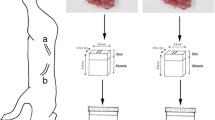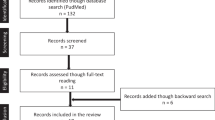Abstract
Purpose
Calculating the timing of bruises is crucial in forensic pathology but is a challenging discipline in both human and veterinary medicine. A mechanical device for inflicting bruises in pigs was developed and validated, and the pathological reactions in the bruises were studied over time in order to identify gross and histological parameters that may be useful in determining the age of a bruise.
Methods
The mechanical device was able to apply a single reproducible stroke with a plastic tube that was equivalent to being struck by a man. In each of 10 anesthetized pigs, four strokes that resulted in bruises were inflicted on the back. In addition, 2 control pigs were included in the study. The pigs were euthanized consecutively from 1 to 10 h after the infliction of bruises. Following gross evaluation, skin, and muscle tissues were sampled for histology.
Results
Grossly, the bruises appeared uniform and identical to the tramline bruises seen in humans and pigs subjected to blunt trauma. Histologically, the number of neutrophils in the subcutis, the number of macrophages in the muscle tissue, and the localization of neutrophils and macrophages in muscle tissue showed a time-dependent response. Combining these parameters, bruises could be grouped as being either less than 4 h old or between 4 and 10 h of age. Gross lesions and changes in the epidermis and dermis were inconclusive with respect to time determination.
Conclusions
The model was reproducible and resembled forensic cases of bruises in pigs and humans. Therefore, the histological parameters are suitable for age determination of bruises in pigs and likely also in humans.











Similar content being viewed by others
References
Hamdy M, Kunkle L, Deatherage F. Bruised tissue 2. Determination of the age of a bruise. J Anim Sci. 1957;16:490–5.
Hamdy M, May K, Flanagan W, Powers J. Determination of the age of bruises in chicken broilers. Poult Sci. 1961;40:787–9.
Hamdy M, May K, Powers J. Some physical and physiological factors affecting poultry bruises. Poult Sci. 1961;40:790–5.
McCausland P, Dougherty R. Histological ageing of bruises in lambs and calves. Aust Vet J. 1978;54:525–7.
Northcutt J, Buhr R, Rowland G. Relationship of broiler bruise age to appearance and tissue histological characteristics. J Appl Poult Res. 2000;9:13–20.
Thornton R, Jolly R. The objective interpretation of histopathological data—an application to the aging of ovine bruises. Forensic Sci Int. 1986;31:225–39.
Takamiya M, Saigusa K, Kumagai R, Nakayashiki N, Aoki Y. Studies on mRNA expression of tissue-type plasminogen activator in bruises for wound age estimation. Int J Leg Med. 2005;119:16–21.
Randeberg LL, Winnem AM, Langlois NE, Larsen ELP, Haaverstad R, Skallerud B, Haugen OA, Svaasand LO. Skin changes following minor trauma. Lasers Surg Med. 2007;39:403–13.
Sun J, Wang Y, Zhang L, Gao C, Zhang LZ, Guo Z. Time-dependent expression of skeletal muscle troponin I mRNA in the contused skeletal muscle of rats: a possible marker for wound age estimation. Int J Leg Med. 2010;124:27–33.
Mao S, Fu F, Dong X, Wang Z. Supplementary pathway for vitality of wounds and wound age estimation in bruises using the electric impedance spectroscopy technique. J Forensic Sci. 2011;56:925–9.
Du Q, Sun J, Zhang L, Liang X, Guo X, Gao C, Wang Y. Time-dependent expression of SNAT2 mRNA in contused skeletal muscle of rats: a possible marker for wound age estimation. Forensic Sci Med Pathol. 2013;9:528–33.
Ross C, Byard RW, Langlois NEI. Does the intensity of the inflammatory reaction in a bruise depend on its proximity to the site of trauma? Forensic Sci Med Pathol. 2013;9:358–62.
Langlois NEI, Olds K, Ross C, Byard RW. Heme oxygenase-1 and heme oxygenase-2 expression in bruises. Forensic Sci Med Pathol. 2015;11:482–7.
Pilling ML, Vanezis P, Perrett D, Johnston A. Visual assessment of the timing of bruising by forensic experts. J Forensic Leg Med. 2010;17:143–9.
Grossman SE, Johnston A, Vanezis P, Perrett D. Can we assess the age of bruises? An attempt to develop an objective technique. Med Sci Law. 2011;51:170–6.
Thavarajah D, Vanezis P, Perrett D. Assessment of bruise age on dark-skinned individuals using tristimulus colorimetry. Med Sci Law. 2012;52:6–11.
Neumayer B, Hassler E, Petrovic A, Widek T, Ogris K, Scheurer E. Age determination of soft tissue hematomas. NMR Biomed. 2014;27:1397–402.
Stephenson T, Bialas Y. Estimation of the age of bruising. Arch Dis Child. 1996;74:53–5.
Hughes VK, Ellis PS, Langlois NEI. The practical application of reflectance spectrophotometry for the demonstration of haemoglobin and its degradation in bruises. J Clin Pathol. 2004;57:355–9.
Hughes VK, Ellis PS, Langlois NEI. Alternative light source (polilight) illumination with digital image analysis does not assist in determining the age of bruises. Forensic Sci Int. 2006;158:104–7.
Byard RW, Wick R, Gilbert JD, Donald T. Histologic dating of bruises in moribund infants and young children. Forensic Sci Med Pathol. 2008;4:187–92.
Hughes VK, Langlois NEI. Use of reflectance spectrophotometry and colorimetry in a general linear model for the determination of the age of bruises. Forensic Sci Med Pathol. 2010;6:275–81.
Stam B, van Gemert JC, van Leeuwen TG, Teeuw AH, van der Wal AC, Aalders MCG. Can color inhomogeneity of bruises be used to establish their age? J Biophotonics. 2011;4:759–67.
Hughes VK, Langlois NEI. Visual and spectrophotometric observations related to histology in a small sample of bruises from cadavers. Forensic Sci Med Pathol. 2011;7:253–6.
Barington K, Jensen HE. Experimental animal models of bruises in forensic medicine—a review. Scand J Lab Anim Sci. 2015;41:1–8.
Herron AJ. Pigs as dermatologic models of human skin disease. In: Proceedings of the ACVP/ASVCP annual meetings. Monterey, CA; 2009.
Swindle MM, Makin A, Herron AJ, Clubb FJ Jr, Fraizer KS. Swine as models in biomedical research and toxicology testing. Vet Pathol. 2012;49:344–56.
Barington K, Jensen HE. Forensic cases of bruises in pigs. Vet Rec. 2013;173:526–30.
Saukko P, Knight B. The pathology of wounds. In: Saukko P, Knight B, editors. Knight’s forensic pathology. London: Arnold; 2004. p. 136–73.
Armstrong EJ. Distinctive patterned injuries caused by an expandable baton. Am J Forensic Med Pathol. 2005;26:186–8.
Vanezis P. Interpreting bruises at necropsy. J Clin Pathol. 2001;54:348–55.
Madsen LW, Jensen HE. Necropsy of the pig. In: Jensen HE, editor. Necropsy. A handbook and atlas. Denmark: Biofolia; 2011. p. 83–134.
Betz P. Histological and enzyme histochemical parameters for the age estimation of human skin wounds. Int J Legal Med. 1994;107:60–8.
van der Laan N, de Leij L, ten Duis HJ. Local cellular inflammation as a result of elective standardized vascular surgery. Acta Histochem. 2001;103:139–49.
Oehmichen M. Vitality and time course of wounds. Forensic Sci Int. 2004;144:221–31.
Langlois NEI. The science behind the quest to determine the age of bruises—a review of the English language literature. Forensic Sci Med Pathol. 2007;3:241–51.
Acknowledgments
The project was funded by University of Copenhagen, Denmark. The funding source had no involvement in the experimental design, analysis and interpretation of the results. We would like to thank Elisabeth W. Petersen, Betina G. Andersen, Dennis Brok, and Frederik Andersen for technical assistance. All applicable international, national and/or institutional guidelines for the care and use of animals were followed. The experimental procedure was approved by the Danish Animal Inspectorate (2013-15-2934-00849).
Author information
Authors and Affiliations
Corresponding author
Rights and permissions
About this article
Cite this article
Barington, K., Jensen, H.E. A novel, comprehensive, and reproducible porcine model for determining the timing of bruises in forensic pathology. Forensic Sci Med Pathol 12, 58–67 (2016). https://doi.org/10.1007/s12024-016-9744-6
Accepted:
Published:
Issue Date:
DOI: https://doi.org/10.1007/s12024-016-9744-6




